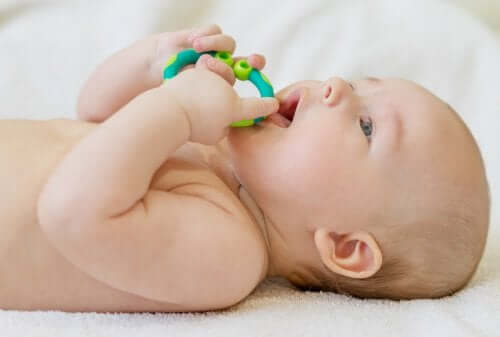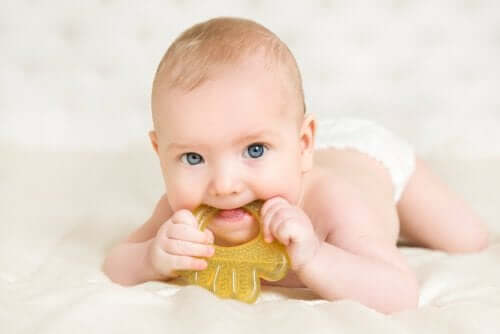How to Choose the Best Teether for Your Baby

When babies’ first teeth appear, they suffer a lot, become upset, and want to bite everything they can find to relieve their sore gums. Therefore, buying a teether for your baby is essential to helping overcome this stage. Find out which one to choose in the following article.
When to buy a teether for your baby
Many parents wonder whether teethers are useful or not. This kind of toy is one of the first that babies receive when they start putting everything in their mouth.
When this happens, it’s because their first teeth are appearing. Biting anything they can find relieves the pain and discomfort that teething causes.
Symptoms of the eminent appearance of teeth can begin after three months, even though teeth actually start appearing at six months. Some indications of this stage are:
- Red gums.
- Excessive salivation.
- Restlessness, crying, and shorter naps.
- Spitting out their pacifier and putting their hands in their mouths.
Biting any object around them.
To make sure your baby doesn’t bite everything around him (including your arms or hands), you can choose to buy a teether, an object that’s specially designed to reduce the symptoms of teething.
Characteristics and benefits of a baby teether
As we stated above, the appearance of teeth is rather bothersome for a baby. Therefore, offering your baby this element can help him during this painful stage. The main advantage of teethers is that they relieve discomfort. In addition, they have other benefits, such as:
- They have a correct shape to be held with their hands and are of different textures.
- They’re eye-catching and help improve sight.

- Some of them have sound components (such as a rattle), thus stimulating auditory function.
- They’re made with natural and non-toxic materials.
- You can freeze or cool them to relieve gum pain and inflammation.
- Your baby can use them as toys once they don’t need to relieve their discomfort.
What teether should you buy your baby?
On the market, you can find dozens of different teethers, which is why it can be hard to choose. Beyond the brand, design, or price, it needs to meet certain requirements:
1. Made with natural or hypoallergenic materials
The most common teethers are made with silicone or natural rubber. It isn’t convenient to buy one made of plastic or other materials.
2. Make sure it doesn’t have small parts
Given that babies will put it in their mouths, it’s dangerous if it has small parts, as they may detach and cause choking.
3. Make sure it’s easy to manipulate
When babies are still a few months old, they don’t have the ability to hold very large or heavy objects. Therefore, the teether should be easy to hold with their hands.
4. Make sure it has no batteries and that it isn’t electric
You may have seen some models that have light and sounds. In order to operate, they surely have batteries or have to be plugged in. This is very dangerous for babies! Don’t forget they’ll always have it in their mouths.
5. Make sure you can freeze it
Experts mostly recommend teethers that you can put in the refrigerator or freezer because they reduce gum pain and swelling. The teethers that can be frozen or cooled are filled with water, not gel.
6. Make sure it’s round and doesn’t have any tips
Most teethers are circular. Have you ever wondered why? Because, this way, babies can put them in their mouths without any problem and can hold them, and they don’t cause any injury or scratches.

A teether is completely beneficial and useful for a baby when they’re teething. If you have any questions about how it should be or when to offer it to your child, ask your pediatrician or pediatric dentist. They can give you more information and recommend any particular design they consider appropriate for your baby.
When babies’ first teeth appear, they suffer a lot, become upset, and want to bite everything they can find to relieve their sore gums. Therefore, buying a teether for your baby is essential to helping overcome this stage. Find out which one to choose in the following article.
When to buy a teether for your baby
Many parents wonder whether teethers are useful or not. This kind of toy is one of the first that babies receive when they start putting everything in their mouth.
When this happens, it’s because their first teeth are appearing. Biting anything they can find relieves the pain and discomfort that teething causes.
Symptoms of the eminent appearance of teeth can begin after three months, even though teeth actually start appearing at six months. Some indications of this stage are:
- Red gums.
- Excessive salivation.
- Restlessness, crying, and shorter naps.
- Spitting out their pacifier and putting their hands in their mouths.
Biting any object around them.
To make sure your baby doesn’t bite everything around him (including your arms or hands), you can choose to buy a teether, an object that’s specially designed to reduce the symptoms of teething.
Characteristics and benefits of a baby teether
As we stated above, the appearance of teeth is rather bothersome for a baby. Therefore, offering your baby this element can help him during this painful stage. The main advantage of teethers is that they relieve discomfort. In addition, they have other benefits, such as:
- They have a correct shape to be held with their hands and are of different textures.
- They’re eye-catching and help improve sight.

- Some of them have sound components (such as a rattle), thus stimulating auditory function.
- They’re made with natural and non-toxic materials.
- You can freeze or cool them to relieve gum pain and inflammation.
- Your baby can use them as toys once they don’t need to relieve their discomfort.
What teether should you buy your baby?
On the market, you can find dozens of different teethers, which is why it can be hard to choose. Beyond the brand, design, or price, it needs to meet certain requirements:
1. Made with natural or hypoallergenic materials
The most common teethers are made with silicone or natural rubber. It isn’t convenient to buy one made of plastic or other materials.
2. Make sure it doesn’t have small parts
Given that babies will put it in their mouths, it’s dangerous if it has small parts, as they may detach and cause choking.
3. Make sure it’s easy to manipulate
When babies are still a few months old, they don’t have the ability to hold very large or heavy objects. Therefore, the teether should be easy to hold with their hands.
4. Make sure it has no batteries and that it isn’t electric
You may have seen some models that have light and sounds. In order to operate, they surely have batteries or have to be plugged in. This is very dangerous for babies! Don’t forget they’ll always have it in their mouths.
5. Make sure you can freeze it
Experts mostly recommend teethers that you can put in the refrigerator or freezer because they reduce gum pain and swelling. The teethers that can be frozen or cooled are filled with water, not gel.
6. Make sure it’s round and doesn’t have any tips
Most teethers are circular. Have you ever wondered why? Because, this way, babies can put them in their mouths without any problem and can hold them, and they don’t cause any injury or scratches.

A teether is completely beneficial and useful for a baby when they’re teething. If you have any questions about how it should be or when to offer it to your child, ask your pediatrician or pediatric dentist. They can give you more information and recommend any particular design they consider appropriate for your baby.
All cited sources were thoroughly reviewed by our team to ensure their quality, reliability, currency, and validity. The bibliography of this article was considered reliable and of academic or scientific accuracy.
- Bayer, P., & Beatrix, B. (2000). Tooth eruption. Trends in Biochemical Sciences. https://doi.org/10.1016/S0968-0004(00)01637-6
This text is provided for informational purposes only and does not replace consultation with a professional. If in doubt, consult your specialist.








